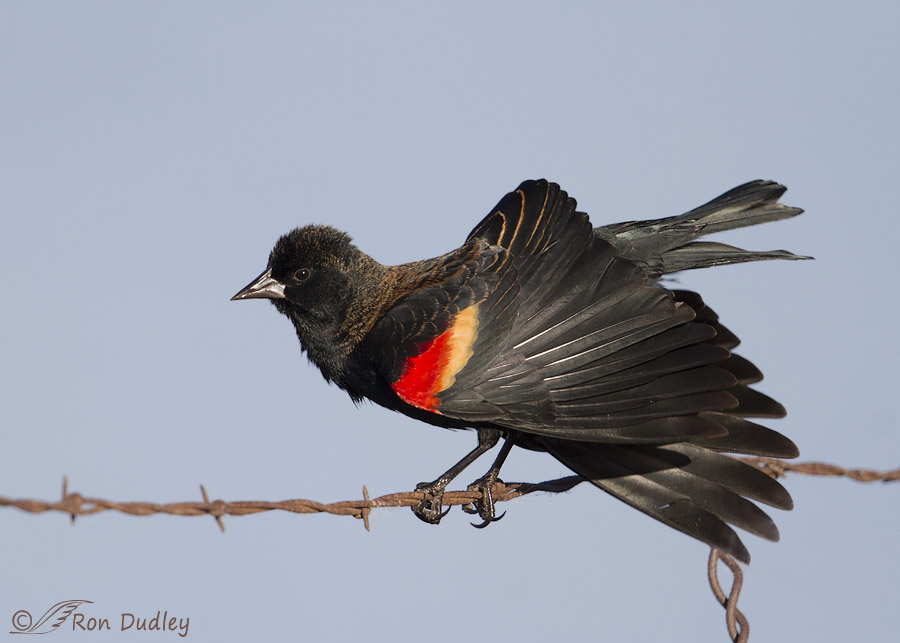Black birds of any species are generally a tough exposure. Throw in the bright red and yellow epaulets of the Red-winged Blackbird and the challenge can be even more daunting.

1/1600, f/6.3, ISO 640, Canon 7D, Canon EF500mm f/4L IS II USM +1.4, not baited, set up or called in
I photographed this displaying male four days ago at Glover Pond in Farmington. The light angle on the bird was just about right to get detail in the blacks without blowing out the reds and yellows since I had to set exposure compensation at +2/3 to expose this dark bird properly. I’ve pretty much given up on photographing blackbirds unless the sun is relatively low and almost directly behind me (as it was here).
I thought the pose was interesting and there’s even some detail on the face which can be difficult to get. The barbed wire perch won’t have universal appeal but at least it’s rusty instead of shiny metal. The background is Glover Pond.
I like to study images like this to give me a better feel for the effects of depth of field on sharpness. Notice that critical sharpness is already lost at the first barb on the wire in front of the left foot and behind the lowered wings. If the bird’s body and been aligned perfectly with the wire the head, tail and part of the wings would have been soft (depending on where my focus point was of course) but since the bird is turned at an angle on the wire and parallel to me the entire blackbird is acceptably sharp.
Paying attention to technical details like this helps to give me a better understanding of what camera settings I need in the field in a particular situation to get the effect I want. But birds, especially small ones, tend to move and change positions so quickly that the photographer must be pretty nimble at changing camera settings to take full advantage of that understanding.
I’m still working on that nimbleness thing…
Ron


Terrific photograph, Ron! Most folks are completely unaware of the range of colors that can be found in a common “black” bird. I’m trying harder to maintain awareness of where my light source is, attempting to get shots when the bird is parallel to the lens, keeping that shutter speed high – it’s paying off. Thanks for your demonstrations of what can be achieved!
Wow! Best Redwing shot I’ve ever seen Ron!
Charlotte
I learn so much from you, thank you so much.
Wow, what a nice shot.
I once read that the red wing blackbird population can indicate the overall health of an area. Not sure where I read that..but it was on “teh interwebz” so it must be real.
Well, if that’s where you found it Arwen, it must be true…
This put a smile on my face. We get these birds in our yard now and then, but I never was able to get close enough to see the rust color in the feathers (neck area). Not sure if that is due to you living in a different area or what. I live in the high desert, So. Calif.
Beautiful bird.
Thanks, Jean. In breeding plumage adult males don’t show the rust colors.
Another stunning image of (another) stunning bird. Thank you.
And if the bird can happily adapt to the barbed wire, so can I.
I can adapt to the wire too, Elephant’s Child. Actually I don’t mind rusty wire too much since I’ve seen so many birds acclimated to it for my entire life. Still prefer natural perches though… Thank you.
Ron, Your images are spectacular already, I can not imagine them getting better with the 7D Mark II. I just got mine this past Friday and love it. The noise control is so much better. I am able to shoot at the same high shutter speeds but get more DOF and shoot in lower light. Be sure to get the new DPP 4.1, I like that even more than Lightroom. Much easier to work than the earlier versions of DPP.
Rich Reynolds
I’m delighted to hear about the better control of noise in the Mark ll, Rich – it’s been a long time coming with Canon’s cropped sensor cameras. Hopefully I’ll get my camera tomorrow. I don’t use Lightroom but I’ll sure use DPP until Adobe upgrades ACR. Thanks for the info!
I think it’s fine that the barbed wire fades out quickly, since it is technically part of the background, and since it’s not particularly attractive. To me it makes the barbed wire more incidental. Love the detail visible on the bird. Clearly your choice of settings got exactly what you wanted/needed to get.
Thank you, Susan.
The clarity and sharpness of color and feather detail is excellent Ron. As I have said before, I have learned a lot from you and your pictures. Many of my settings are now above 1/1200 to 1/5000 + and can’t believe the quality I am finding.
I like the position the blackbird is in, the subtle position of the captured wing. Blackbirds are tough, this is a fine shot!
Thanks for sharing.
Dick, particular settings are often a trade-off, especially shutter speed. Birds are just so darned quick and unpredictable, especially during certain behaviors, that I feel that I gain more with fast SS’s than I lose to noise and DOF. But those choices are also a matter of style to some degree. I love photographing behaviors so my “default” is relatively fast shutter speeds. Others shoot differently and that’s fine for them I’m sure.
Ron that’s a gorgeous capture … fabulous capture of his wing display … wonderful detail!!!!! Those blacks are very difficult to get (I know this … trust me!) … my hat’s off to you!!!!
I certainly do “trust you”, Lois – you do understand the exposure problem. Thanks very much.